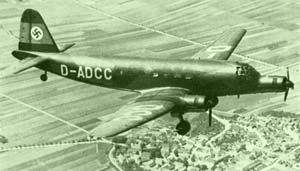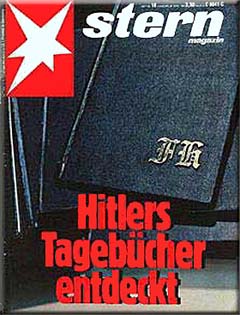The
Hitler Diaries
|

Hitler
in Paris: Did he keep a diary?
|
It would have been one of the greatest historical
buys of the 20th century: Sixty-two handwritten volumes of a secret
diary kept by Adolf Hitler. Der Stern Magazine thought
they had the exclusive rights into one of the darkest minds of
all time. Instead, they paid millions of dollars for a hoax.
In the autumn of 1979 an investigative reporter
for the German magazine Der Stern, Gerd Heidemann, was
invited to the house of a man named Fritz Stiefel, a collecter
of Nazi memorabilia. Stiefel had paintings and letters created
by Hitler laid out in a glass case like a museum display. Heidemann,
a Nazi enthusiast, studied each of them carefully. Finally he
noticed something else in the case: A black book. When he asked
about it he was told that it was a secret diary kept by the Nazi
leader. One of supposedly six volumes.
Heidemann was shocked. He'd been fascinated by the
life of Hitler for years but never heard that the man had kept
a diary. The inner thinking of the Nazi leader had always been
a mystery even to other leading members of the Third Reich. A
true diary would give historians insight into the thinking of
a man who had, for evil, changed the face of the world. Heidemann
realized that if the diaries were authentic and if he could get
a hold of them, he would have one of the biggest journalistic
scoops of the 20th century. To buy the diaries Heidemann knew
he would have to have the economic backing of his magazine
Stern, but before they would give him the money he would have
to make a case for the diaries being authentic.
Tracking
the Diaries
One of Heidemenn's first steps was to try and determine
how the Stiefel's volume of the diary had gotten into his hands.
Stiefel had been told the diary had been aboard a plane carrying
some of the Fuehrer's belongings that had crashed in the village
of Boernersdorf at the end of the war. The first thing that Heidemann
did was to travel to Boernersdorf to confirm the story. There
he found that indeed there had been a plane crash in April of
1945. Records indicated that a Junkers 352 transport went down
carrying some of Hitler's personal effects. When he heard of the
crash Hitler had stated, "In that plane were all my private
archives that I had intended as a testament to posterity. It is
a catastrophe!"
|

A
German transport plane similar to the one that crashed in
Boernersdorf.
|
Heidemann also found that a chest of papers had
supposedly been recovered from the wreck and this was rumored
to be the source of the diaries. He also learned there were 27
more volumes of the diaries in the hands of a man named Konrad
Fischer.
Equipped with this information, Heidemann made a
proposal to his bosses at Stern that they purchase the
diaries. Stern said it would pay as much as 2 million marks
(approximately $800,000) to obtain the diaries. With this money
behind him, Heidemann went searching for Fischer. Fischer turned
out to be hard to find. Eventually Heidemann contacted him through
intermediaries. Fischer seemed reluctant to sell the diaries,
but the amount of money involved won him over. He did inist that
Heidemann promise to keep his identity a secret.
The first diary was delivered to Stern editorial
offices in January of 1981. Surprisingly more and more diaries
kept showing up. Heidemann told his bosses that after the plane
crash the diaries had come into the possession of an East German
general and were being smuggled out of that country one by one
(supposedly inside pianos). With each new volume Stern
paid more money and stood to make more money when they resold
the story to other news media. The final tally was 62 volumes
(covering the period from 1932 to 1945) for which Stern
paid 9.9 million marks (almost $4 million).
Before Stern could resell the story they
needed to make sure the diaries were authentic. To do this they
had handwriting experts compare the diaries with copies of material
found by Heidemann in the German Federal Archives at Koblenz.
Without question the handwriting was identical and Stern's
editors enthusiasm for the project soared, perhaps blinding them
to the need for additional authentication checks.
Breaking
the Story
|

The
April 25, 1983 cover of the German magazine Der Stern.
|
On April 25th, 1983, Stern magazine broke
the story. The cover, showing one of the black bound volumes,
proclaimed "Hitlers Tagebucher Entdeckt" or "Hitler's Diary Discovered."
The news media around the world jumped on the story. Newsweek,
ParisMatch and London's Sunday Times and Times
newspapers all made bids to get the rights to reprint all or part
of the diaries. Stern stood to make a fortune on the reprint
rights.
What the diaries showed was surprising. If one were
to believe the diaries, Hitler was a much more kinder and gentler
man than the historical record showed. In particular, the diary
entries suggested that he had little knowledge of what was happening
in the concentration camps scattered around Europe. He also expressed
a desire to deport the Jews to other countries rather than put
them to death.
Even before skeptics got a look at the material
they expressed doubts that the diaries were real. Historians familiar
with Hitler pointed out that he loathed to write and that none
of his intimates in the Nazi organization, including his secretary,
had believed he had kept a diary. When the critics actually got
to look at the material their objections to its authenticity only
increased. Historian David Irving pointed out that what was recorded
in the diaries did not correspond to known historical events and
the materials that the books were composed of appeared to be too
modern for the era. Most damaging of all was the claim by experts
of Hitler's writing that the script in the diaries did not resemble
his at all, especially since the handwriting had been at the heart
of Stern's authentication procedure.
The
Hoax Revealed
West Germany's Federal Archives decided to get involved
and ran several scientific tests on the books. On May 6, 1983,
they released their findings: the paper, ink and glue of the diaries
was undoubtedly manufactured after the end of World War II and
Hitler's death. The volumes for which Stern had paid millions
of dollars were worthless forgeries.
Stern realized that it had been taken and
heads began to roll. Several members of the staff (including Heidemann)
were fired. In addition Stern's founder, Henri Nannen,
filed fraud charges against Heidemann several days later and the
police began to investigate. It quickly became clear that Heidemann
had not forged the diaries himself. Heidemann gave up Fischer's
name and the investigation soon focused on him. The police soon
discovered that Fischer's real name was Konrad Kujau. Kujau was
a petty criminal who specialized in forgery. He had started by
taking legitimate Nazi memorabilia and adding the names of important
Nazis to increase the value. Later on he started forging entire
works including letters, documents and even paintings and sketches
allegedly done by Hitler. In a 1983 book by Billy Price called
Adolf Hitler: The Unknown Artist a quarter of the works
pictured were actually forgeries by Kujau.
Kujau's prolific forgery solved the mystery of how
the Stern handwriting experts had been fooled. When they
had compared the handwriting in the diaries to the handwriting
found in letters by Hitler, they pronounced it identical. Indeed
it was. The letters that they had used for comparison turned out
to be previous forgeries by Kujau, not actually letters written
by Hitler.
Kujau, Heidemann and Kujau's wife, Edith, were brought
to trial. Kujau claimed that Heidemann was completely aware that
the documents were forgeries but bought them anyway paying 1 million
marks. Heidemann claimed he hadn't know they were forgeries but
admitted that he had seen the possibility of some historical discrepancies.
Kujau and Heidemann were given four and one half years in prison
and Edith eight months. The judge stated that while there were
only three defendants, the Stern's publishing firm should
be the fourth. He said that Stern had "acted with such
naiveté and negligence that it was virtually an accomplice in
the fraud."
Nobody ever found out what happened to the bulk
of the money paid out by Stern. According to Kujau, Heidemann
skimmed much of it before paying him. Clearly both Kajau and Heidemann's
lifestyle took a turn for the better at the time of the fraud
and most of the money never made it back into Stern's hands.
Could Stern really have avoided the loss
of millions of dollars and its international reputation? It seems
clear in retrospect that the publishing firm could have found
out the truth if they had simply subjected the diaries to a few
scientific tests. Examination of the books themselves showed that
they contained whiteners and threads not manufactured until the
1950's. Chemical tests revealed that the ink was modern and only
recently applied to the paper.
A careful reading of the text would have also revealed
historical inaccuracies that might not have proved the diaries
fake by themselves, but should have raised suspicions. Much of
the material Kujau stole from a book called Hitler's Speeches
and Proclamations written by Max Domarus. This also should
have raised a red flag to anyone carefully trying to authenticate
the diaries.
As the judge indicated, the owners and editors of
Der Stern may have been as much to blame as Kujau and Heidemann.
They were too ready to believe that they had scooped every news
organization in the world on the the story of the Hitler diaries,
and much too ready to profit from it.
A
Partial Bibliography
Selling Hitler by Robert Harris, Pantheon Books,
1986.
The Hitler Diaries: Fakes that Fooled the World by Charles
Hamilton, The University of Kentucky Press, 1991.
The Hitler Diaries, a Notorious Case of Forgery, The Crime
Library, (http://crimelibrary.com/criminal_mind/scams/hitler_diaries/index.htm),
2005.

Copyright 2005,
Lee Krystek. All Rights Reserved.